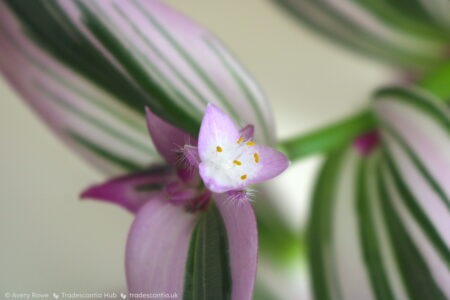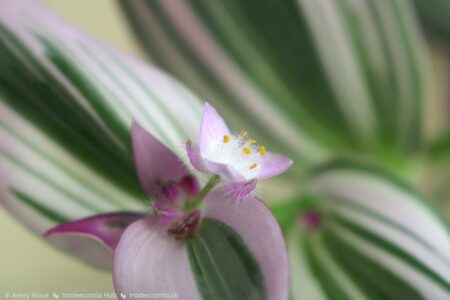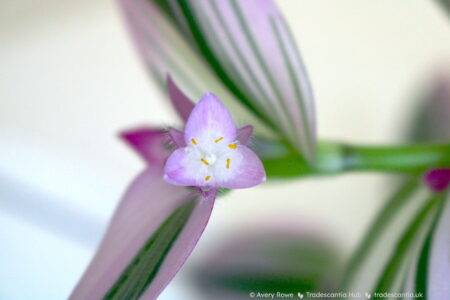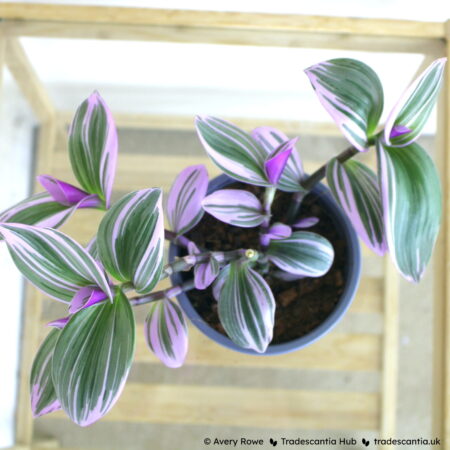Details
| Full name | Tradescantia cerinthoides ‘Nanouk’. |
| Name status | Accepted, the valid name for a unique cultivar. Established with a description by Succulents Innovations B.V. (2018). Because it is a legal protection registration, the name must be accepted permamently over any other (Brickell et al., 2016, Arts. 11.3, 11.4). Also known as:
|
| Origins | Origins described by Succulents Innovations B.V. (2018). Seedling from unknown parents, selected and named by Wander Tuinier in 2012 in the Netherlands. Introduced by Dümmen Group B.V. |
| Classification | The original legal protection identifies the plant as Tradescantia albiflora, which is a botanical synonym for Tradescantia fluminensis (POWO, 2022). But the plant does not match that species – it is now identified as Tradescantia cerinthoides based on Pellegrini (2018). |
| Legal protection | Patented in the USA (Tuinier, 2018). Protected by plant breeder’s rights in the EU and UK (Succulents Innovations B.V., 2018). Protected by plant breeder’s rights in Australia (Dummen Group B.V., 2020). |
| Availability | Mass-produced and widely available. |
Description
Preserved in a herbarium specimen (“Tradescantia cerinthoides ‘Nanouk'”, 2023).
Described with reference to the RHS Colour Chart (6th Edition; 2019 reprint).
| Species | Tradescantia cerinthoides. |
| Growth habit | Strong stems initially grow upright, but begin to sprawl and trail as they get longer. |
| Foliage | Stems are 3-7mm thick with internodes 2-9cm long, dark yellowish green (189A) to dark greyish red (N186C), smooth except for a single line of tiny hairs along the length. Leaves are ovals, 5-12cm long and 2-5cm wide, with marginal variegation. The pale background on the upper surfaces ranges from light purplish grey (N187D) or very pale purple (76C) in bright light, to strong yellow green (144C) in lower light. The dark stripes are a mixture of colours from dark greyish green (N189A) to greyish yellow green (191A). In bright light, the undersides are strong purple (N81B) in pale areas and dark purple (79C) to dark purplish red (N79A) in dark areas. In lower light, the undersides are light purplish grey (N187D) in pale areas and greyish yellow green (191A to 194A) in dark areas. Leaf sheaths are greyish purplish red (N77D). |
| Flowers | 12-15mm across. Petals are white at the base and light reddish purple (N75A) to light purple (N81D) at the tips. The sepals are covered with hairs on the outer surface. |
References
Brickell, C. D., Alexander, C., Cubey, J. J., David, J. C., Hoffman, M. H. A., Leslie, A. C., Malécot, V., Jin, X. (2016). International Code of Nomenclature for Cultivated Plants. PDF link.
Pellegrini, M. O. O. (2018). Wandering throughout South America: Taxonomic revision of Tradescantia subg. Austrotradescantia (D.R.Hunt) M.Pell. (Commelinaceae). PhytoKeys 104: 1-97. https://doi.org/10.3897/phytokeys.104.28484.
Succulents Innovations B.V. (2018, April 23). Tradescantia albiflora ‘Nanouk’ [EU plant breeder’s rights registration 49012]. Community Plant Variety Office. Registration document link.
Tuinier, W. D. (2018, September 25). Tradescantia plant named ‘Nanouk’ [US plant patent PP29,711 P2]. United States Patent and Trademark Office. Internet Archive link.
Dummen Group B.V. (2020, October 14). Tradescantia albiflora ‘Nanouk’ [Australia plant breeder’s rights registration 2020/155]. IP Australia. Registration document link.
POWO. (2022). Tradescantia albiflora. Plants of the World Online. Link.
Tradescantia cerinthoides ‘Nanouk’. (2023). [Herbarium specimen, barcode WSY0168564]. RHS Wisley Herbarium.




